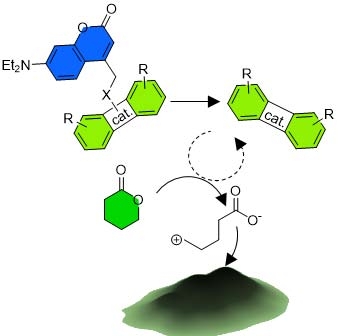Master 2 internships
A nanometrology approach to understanding and optimizing photocatalytic polymerization of biosourced monomers
Finding biosourced alternatives for preparing commodity polymers is an important goal towards more sustainable industry. Polyesters, for example, are one of the most widely used polymer in the textile industry, strongly relying on precursors from fossil origin. Since a few years, we have been interested in developing a greener alternative for preparing these materials, based on ring opening polymerization of lactones, as indicated in Fig.1.
We have developed photocaged catalysts based on thiourea molecules, which become active towards the polymerization of lactones upon illumination with visible light. These molecules were next used to conceive a local polymerization system, which we have integrated into a direct laser writing setup to develop micro structured layers. Preliminary work has stablished a proof-of-principle for the light activated polymerization reaction, identified optimal irradiation regimes and revealed some of the key intermediaries generated in the reaction. Building on these results, we now seek to understand how to influence the reaction outcome based on the photopolymerization system formulation. Relying on a combination of operando nanometrology analysis, ex-situ mass spectrometry and visible spectroscopies, the goal of this internship is to analyze how the local polymerization properties can be changed based on the medium formulation.
Internship period: From January 2025.
Profile required: we are looking for a motivated M2 or M1 students with a background in physical chemistry or chemical physics. Knowledge of basic scientific programming and interest for the development of original instrumentation would be a plus, but are not mandatory. The intern will receive dedicated training in several analytical techniques. The topic is inserted upon a national consortium (SUNRISE, PEPR LUMA), for which PhD funding has also been secured
For more information, contact Dr V. Brasiliense or Dr N. Bogliotti
